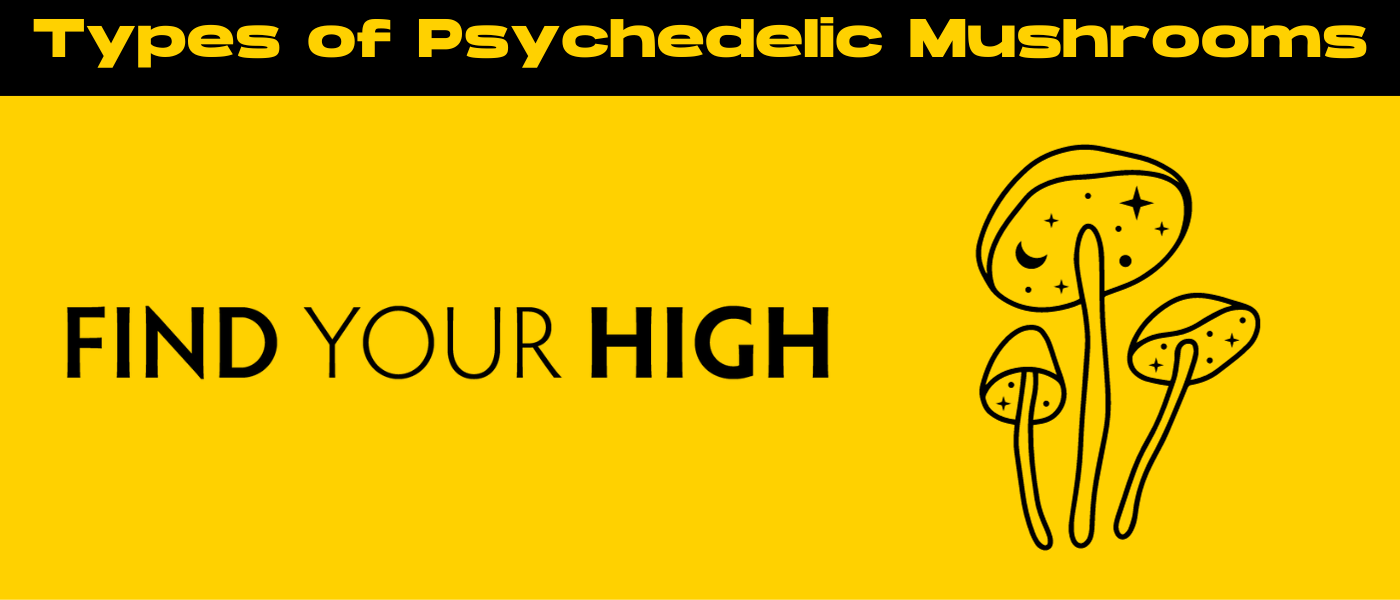Have you ever wondered about those fun fungi called magic mushrooms? If so, you’ve landed at the right place because, in this blog, we’re discussing different types of psychedelic mushrooms!
Psychedelic shrooms have been leaving their spore prints across history and culture for millennia. They’ve influenced societies, from the ancient tribes who first discovered their trippy properties, to the hipster artist in your local coffee shop.
In this blog, we’ll set off on a ‘trip’ of discovery, exploring the captivating world of hallucinogenic mushrooms, their historical significance, and much more. So buckle up for a mind-expanding journey that we hope is just as captivating as the magic mushrooms themselves!
Key Psychedelic Compounds
When it comes to magic mushrooms, we can’t forget to introduce the dynamic duo behind their mind-altering magic: Psilocybin and Psilocin.
Psilocybin is a naturally occurring psychedelic compound present in over 200 species of mushrooms, including the potent Penis Envy mushroom.
Upon ingestion, it is rapidly converted in the human body into psilocin, which induces a hallucinogenic experience.
Once psilocybin enters the body, it is broken down into psilocin, which then interacts with serotonin receptors in the brain. This interaction changes perception and mood, resulting in commonly reported ‘trippy’ experiences like visual hallucinations, intense emotions, and a different sense of time and reality.
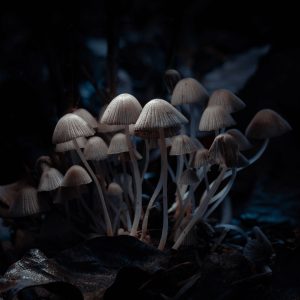
Baeocystin and Norbaeocystin
Magic mushrooms also contain lesser-known compounds, such as Baeocystin and Norbaeocystin. Although present in smaller quantities, these compounds contribute to the overall psychedelic experience.
Some research suggests that they might enhance or alter the ‘trip’, even though we don’t fully grasp their exact role yet. But one thing’s for sure, they bring an extra layer of complexity and intrigue to the captivating world of magic mushrooms.
Popular Types of Hallucinogenic Mushrooms
Let’s explore a few popular types of hallucinogenic mushrooms!
From the well-known Psilocybe cubensis to the lesser-known Panaeolus cyanescens, we’ll dive into some of the most popular species renowned for their mind-altering effects in the following sections.
Psilocybe Cubensis
Psilocybe Cubensis, often referred to as “Gold Caps,” is one of the most popular and abundantly found magic mushrooms.
- Common Characteristics: They are renowned for their golden-colored caps and dark purple spores. A unique feature is their ability to grow in a variety of climates and substrates, mainly cow dung.
- Regional Variations and Strains: Psilocybe Cubensis mushrooms have several strains, such as the Golden Teacher and B+ strains, each with unique characteristics. They are found mostly in subtropical regions, including Southeast Asia, Australia, and South America.
Psilocybe Semilanceata
Commonly known as the Liberty Cap, Psilocybe Semilanceata is a potent psychedelic mushroom.
- Known as Liberty Cap: Named for its distinctive cap shape, which resembles a Revolutionary War liberty cap, it is quite potent compared to its size.
- Preferred Habitat and Global Distribution: They are usually found in damp, grassy fields typically populated by cattle or sheep and are widely distributed across North America, Europe, Asia, South America, Australia, and New Zealand.
Psilocybe Cyanescens
The Psilocybe Cyanescens, also known as “Wavy Caps,” are known for their high psilocybin content.
- Potency and Unique Features: Psilocybe Cyanescens are significantly more potent than Psilocybe Cubensis. They get their nickname from their characteristically wavy cap edges.
- Habitat and Geographical Prevalence: These mushrooms tend to grow on decaying wood chips and are prevalent in the Pacific Northwest.
Amanita Muscaria
Amanita Muscaria, or Fly Agaric, is a different type of psychedelic mushroom known for its iconic appearance in popular culture.
- Distinct Appearance and Reputation: Famous for their red and white-spotted caps, these mushrooms have a long history in shamanic rituals, and their image is often associated with magic and fairies.
- Muscimol Content and Effects: Unlike other magic mushrooms, Amanita Muscaria contains the psychoactive compound muscimol instead of psilocybin. Its effects can vary widely, from euphoria, altered perception, and dream-like states to muscle twitching and nausea.
Lesser-Known Psychedelic Mushroom Species
While the species mentioned above have caught a lot of attention, let’s dive into some lesser-known magic mushrooms that bring their own special charm to the trippy world.
Psilocybe Azurescens
Psilocybe Azurescens is a potent species, highly sought by the psychedelic community due to its high psilocybin content.
- Characteristics and Potency: Psilocybe Azurescens has a convex cap that flattens with age and a slender stem. Often referred to as “Flying Saucers,” “Blue Angels,” or “Azzies,” they are recognized as one of the most potent psilocybin mushrooms.
- Ecological Preferences and Growth: Native to the Pacific Northwest, they grow in sandy soils rich in lignicolous debris, particularly along coastal dunes.
Psilocybe Mexicana
Psilocybe Mexicana holds a special place in the history and culture of magic mushrooms.
- Historical Use by Indigenous Cultures: This species was widely used by indigenous Mesoamerican cultures in spiritual and religious ceremonies. Via Spanish chroniclers, we know the Aztecs referred to them as “Teonanácatl,” meaning “god fungus.”
- Cultural and Spiritual Significance: As a sacrament, it was believed to be a conduit to the divine, allowing communication with gods and ancestors. Even today, indigenous communities in Mexico continue to use it for spiritual healing and exploration.
Gymnopilus Species
The Gymnopilus genus comprises several psychedelic species that are not as well-known but are still noteworthy.
- Characteristics and Differentiation: Gymnopilus mushrooms are often bright orange or rusty brown and can be distinguished by their bitter taste. They are commonly known as “laughing gyms” due to the euphoria and laughter they can induce.
- Ecological Niche and Geographic Distribution: Gymnopilus species grow on dead hardwoods and conifer woods, and are found across North America, Europe, Asia, and Australia.
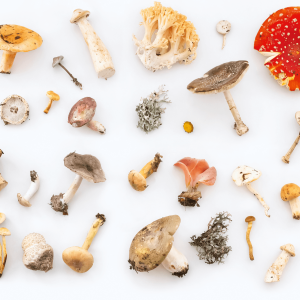
Cultural Perspectives
Hallucinogenic mushrooms hold immense spiritual and cultural significance in indigenous cultures. They’re like a bridge to the spiritual realm, enabling communication with ancestors and deities.
These sacred entities are believed to possess wisdom and healing powers. They’re even used in important rituals and ceremonies that mark significant milestones in life.
Let’s take the Mazatec Indians of Oaxaca, Mexico, for example. They’ve been using Psilocybe mushrooms, fondly known as “holy children,” in their spiritual practices for centuries.
During these ceremonies, an elder or shaman guides people on a mind-bending journey, bringing profound healing and insights.
Contemporary Use
Fast forward to today, we are currently witnessing a “psychedelic renaissance” with a resurgence of interest in the therapeutic and spiritual potential of psychedelics.
Modern practices now involve “microdosing” – taking small, sub-psychoactive doses of psychedelic substances to enhance creativity, mood, and cognitive function.
Psilocybin retreats have also become popular, offering legal, professionally-guided psychedelic experiences in supportive, structured environments.
Integration into Alternative Therapies
Psilocybin-containing mushrooms are making their way into alternative therapies because they have the potential to treat various mental health disorders and conditions.
Research suggests that psilocybin, the active compound in these mushrooms, can help ease depression, anxiety, and PTSD. It’s also being studied for its potential in treating addiction.
These therapies usually combine psychedelic drug use with psychotherapy, offering a holistic approach to mental health treatment.
Legal Status of Psychedelic Drugs
The legal landscape for hallucinogenic mushrooms varies widely around the world.
In many countries, the cultivation, possession, and use of these substances are strictly prohibited. For instance, in the United States, psilocybin is classified as a Schedule I drug under the Controlled Substances Act, meaning it’s illegal to manufacture, distribute, or possess.
However, changes in attitudes towards these substances are leading to substantial shifts in legislation. There is a growing wave of decriminalization movements across different parts of the world.
Multiple cities in the U.S., like Denver, Oakland, and Santa Cruz, have decriminalized the use of hallucinogenic mushroomss. Meanwhile, countries like Brazil, Vietnam, and Portugal have decriminalized all drugs, which includes psychedelics.
The aim of these changes is to shift the focus from punishment to public health and harm reduction. These movements signal a broader trend towards recognizing the potential medical and therapeutic benefits of psychedelics and a step away from the outdated laws of the past.

Psychedelic Research and Therapeutic Applications
Psychedelic mushrooms have been making a comeback in the scientific community in recent years, thanks to some exciting research findings.
There are several studies that indicate the psychoactive compound in these mushrooms, psilocybin, can actually have some positive effects on mental health conditions like depression, anxiety, and post-traumatic stress disorder (PTSD).
Curious? Keep reading to learn more.
Recent Findings on Psychedelic Mushrooms
Check it out: a study in the Journal of Psychopharmacology showed that just one dose of psilocybin could bring long-term relief for anxiety and depression in cancer patients.
Another study even suggested that it could reset the brain’s depressive state, leading to lasting changes in the patient’s mood and outlook. Pretty amazing, right?
Clinical Trials and Therapeutic Potential
In light of these encouraging findings, multiple clinical trials are underway to further explore the therapeutic potential of psychedelic mushrooms.
Organizations like MAPS (Multidisciplinary Association for Psychedelic Studies), Usona Institute, and Johns Hopkins University’s Center for Psychedelic and Consciousness Research are leading the charge.
Initial results suggest that, combined with psychotherapy, psychedelic mushrooms could revolutionize the way we approach mental health treatment. However, more comprehensive, controlled, and long-term studies are necessary to fully understand the clinical efficacy and safety of these substances.
Dosage Guidelines
Knowing the right dosage of magic mushrooms is super important for a safe experience. These mushrooms can pack a punch, with potency varying based on factors like species, growth conditions, and storage. Plus, your personal tolerance levels can affect how intense and long the trip will be.
Needless to say, it’s always a good idea to start with a small, carefully measured dose, especially if you’re new to psychedelics. And remember, there are risks if you don’t consume them responsibly.
Overconsumption can lead to some not-so-fun physical effects and psychological effects like nausea, paranoia, and hallucinations — commonly referred to as a ‘bad trip.’
To minimize any potential harm and maximize the good vibes, make sure to have a knowledgeable guide or professional by your side.
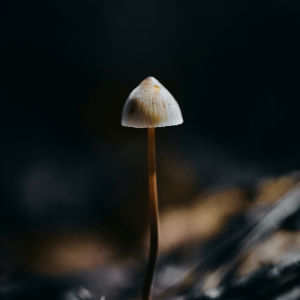
Magic Mushrooms and Mental Health
Magic mushrooms show some really promising potential in the mental health field.
One area that has a lot of people interested is their use in psychedelic-assisted therapy. This cool and innovative approach combines psychedelics with therapy to help patients dig deep into their subconscious and emotions.
Psychedelic-assisted therapy has been found to have long-term positive effects, especially for treating depression, anxiety, and PTSD.
But, like any powerful substance, it’s important to consider mental health and be cautious when using magic mushrooms. They can offer some amazing insights, but they’re not a magic fix.
Psychedelic shrooms shouldn’t replace ongoing mental health care, and it’s always best to have a trained professional supervising their use.
Also, if you’ve had a history of serious mental health conditions, it’s wise to be careful since these substances can potentially make things worse.
Ensuring Safe Identification
Identifying magic mushrooms correctly is absolutely crucial for safety! Misidentification can lead to consuming poisonous mushrooms, which can have serious health consequences.
Magic mushrooms, specifically psilocybin-containing ones, often have certain characteristics that can help in their identification. They usually have dark spore prints, a central stem, and gills under the cap. Some types also have a blue bruising color when handled.
However, these traits can also be found in some poisonous mushroom species. Therefore, the safest way to accurately identify magic mushrooms is through spore print color, mushroom size, shape, color, and habitat.
Remember, if you’re unsure about the identity of a mushroom, it’s best not to consume it. Always consult an experienced mycologist or use a trusted field guide for identification.
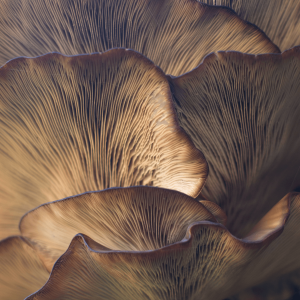
Conclusion: Summarizing the Diversity of Magic Mushrooms
Magic mushrooms present a fascinating and complex dimension of the natural world.
Their potential therapeutic application, particularly in the field of mental health, opens up intriguing avenues for research and practice. As with any potent substance, these mushrooms demand respect and careful handling.
When it comes to dosage, more is not necessarily better. Responsible use calls for starting small, respecting personal tolerance levels, and understanding the potential effects.
Magic mushrooms have shown potential in treating various mental health issues, but they are not a standalone solution. They’re best used as a part of a comprehensive therapeutic approach, under the supervision of a trained professional.
Cultivating your own mushrooms allows for control over the quality and safety, but it’s crucial to remember that laws regarding cultivation vary worldwide.
The realm of magic mushrooms is rich and diverse, and exploring it can provide profound insights and experiences. However, this exploration must always be conducted with respect for the potential risks and effects.
Be cautious, educate yourself well, and always prioritize safety when setting off on a psychedelic mushroom journey.
Remember, the journey to understanding and harnessing the potential of magic mushrooms is a marathon, not a sprint. Enjoy the process, and stay safe.
Frequently Asked Questions
1. What are the most common types of magic mushrooms?
The most common types of magic mushrooms include Psilocybe cubensis, Psilocybe semilanceata, Psilocybe azurescens, and Panaeolus cyanescens.
Psilocybe cubensis, known as “Golden Tops” or “Cubes,” is the most widely recognized and cultivated species around the world.
Psilocybe semilanceata, also referred to as the “Liberty Cap,” is prolific in the wild, especially in the northern hemisphere.
Psilocybe azurescens, commonly known as “Flying Saucers,” are notable for their high psilocybin content.
Lastly, Panaeolus cyanescens, also called “Blue Meanies,” are recognized for their distinctive blue bruising and potent psychedelic effects.
These are just a few examples, and there are many more species out there waiting to be discovered!
2. What distinguishes psilocybin mushrooms from other types of mushrooms?
Psilocybin mushrooms distinguish themselves from other types of mushrooms due to their psychoactive properties.
These mushrooms contain naturally occurring psychedelic compounds, primarily psilocybin, which upon ingestion, is converted to psilocin that causes hallucinogenic effects.
Characteristically, many psilocybin mushrooms have a blue bruising color when handled, dark spore prints, and a central stem with gills under the cap. However, these traits alone are not definitive, and accurate identification requires thorough knowledge of mushroom anatomy and habitat.
3. Can all types of magic mushrooms be used for medicinal purposes?
While many types of magic mushrooms contain psilocybin, a compound known for its therapeutic potential, it’s important to note that not every variety is suitable for medicinal use.
Some may contain other substances that can be harmful or have uncomfortable side effects. Therefore, any medicinal use of magic mushrooms should be guided by scientific research and medical supervision.
It’s also critical to remember that, despite their potential benefits, these substances are still illegal in many parts of the world. Always adhere to local laws and regulations.
4. Can you eat magic mushrooms fresh, or do they need to be dried?
Both fresh and dried magic mushrooms can be consumed. Fresh mushrooms, typically, have a moist, slimy texture and a strong earthy flavor. The drying process, on the other hand, helps preserve the mushrooms and can potentially intensify their psychoactive effects.
However, it’s essential to note that the potency of psilocybin can vary greatly between fresh and dried mushrooms, as well as between different species. For this reason, dosage should always be carefully considered and adjusted accordingly.
It’s recommended to start with a lower dose, especially for those new to psychedelic mushrooms, to avoid uncomfortable or overwhelming experiences.
5. How do you identify a psilocybin mushroom?
Identifying a psilocybin mushroom involves careful attention to various characteristics of the mushroom. These include the color, shape, spore print color, bruising, habitat, and season of the mushroom.
- Color and Shape: The color and shape of both the cap and stem can provide useful clues. Psilocybin mushrooms typically have a conic, convex, or flat cap, and the color can range from brown to yellow, or even white. The stem is often slender, fibrous, and whitish or yellowish.
- Spore Print: The color of the spore print can also help identify psilocybin mushrooms. Most psilocybin mushrooms leave a dark purple-brown to black spore print.
- Bruising: Many psilocybin mushrooms display a bluish or greenish bruising where they’ve been handled or damaged. This is due to the oxidation of psilocin, one of the psychedelic compounds present in these mushrooms.
- Habitat and Season: Psilocybin mushrooms grow in a variety of habitats, depending on the species. Some grow on the ground in pastures, while others prefer decaying wood. Most species of psilocybin mushrooms are found during the fall, or in the rainy seasons.
In spite of these common features, it’s important to note that there are many different species of psilocybin mushrooms, and each has its own unique characteristics.
Great caution should be exercised when attempting to identify them, as there are also many poisonous mushrooms that can look similar.
6. Are there poisonous mushrooms that look like psychedelic ones?
Yes, there are indeed poisonous mushrooms that look similar to psychedelic ones. This is why it’s absolutely crucial to properly identify any mushroom before consuming it.
Some poisonous species, like the deadly Galerina and Inocybe, can resemble psilocybin mushrooms to the untrained eye. These toxic mushrooms contain harmful substances that can cause serious health problems, ranging from gastrointestinal discomfort to organ failure and even death.
It’s always safer to err on the side of caution and avoid consumption unless you are absolutely certain of a mushroom’s identification. For safer alternatives, consider growing your own mushrooms from spores bought from reputable sources, or explore synthetic psychedelic substances that are legal and regulated in your area.
Always prioritize safety when it comes to psychedelics.
7. What are the potential effects of consuming hallucinogenic mushrooms?
Consuming psychedelic mushrooms can lead to a range of effects, both physical and psychological.
Physically, individuals may experience changes in heart rate, blood pressure, and temperature, pupil dilation, nausea, and in some cases, loss of coordination or dizziness. Psychologically, the effects can be more varied and are highly dependent on the individual’s mindset and environment at the time of consumption.
The most distinct psychological effects include alterations in perception, mood, thought, and self-awareness. Users often report intensified emotions, visual and auditory hallucinations, a distorted sense of time, spiritual experiences, and an altered sense of self. These effects can lead to insightful, pleasurable experiences or, conversely, can cause discomfort and distress.
8. How long do the effects of psychedelic mushrooms last?
The effects of psychedelic mushrooms typically begin within 20 to 40 minutes of ingestion and can last up to 6 hours.
It’s important to remember that everyone’s experience with these substances is unique and can be influenced by various factors, including the individual’s physical health, mental state, and the dosage taken.
9. Can psychedelic mushrooms be addictive?
Psilocybin, the psychedelic compound found in these mushrooms, is not considered addictive as it does not lead to compulsive, escalating use, nor does it produce withdrawal symptoms.
However, users can still develop a tolerance to psilocybin with repeated use, meaning more of the substance would be needed to achieve the same effects.
While it’s not common, it’s also possible for individuals to develop a psychological dependence on the experience, using it as a form of emotional escape.
As with all psychoactive substances, responsible use is key. It’s also recommended to seek professional guidance for therapeutic use.
10. Is it legal to grow my own psychedelic mushrooms?
The legality of growing psychedelic mushrooms varies dramatically from country to country and even within regions of the same country.
In some places, such as the United States, it is illegal to cultivate or possess psilocybin mushrooms due to their classification as a Schedule I drug.
However, there are exceptions in some cities and states. For example, the city of Denver, Colorado, and the state of Oregon have decriminalized the use of psilocybin to some extent.
In other countries, such as Brazil and Vietnam, the use and cultivation of psilocybin mushrooms are legal.
In the Netherlands, while psilocybin mushrooms are illegal, “magic truffles” or “philosopher’s stones,” which are part of the same fungi and contain the same psychoactive substances, are legal to buy, sell, and consume.
It’s essential always to check local laws and regulations before cultivating or consuming psychedelic mushrooms.
Additionally, regardless of the legal status, it’s important to consider the potential risks and benefits, as well as your own mental and physical health, before deciding to use psychedelics.

 Rewards
Rewards




